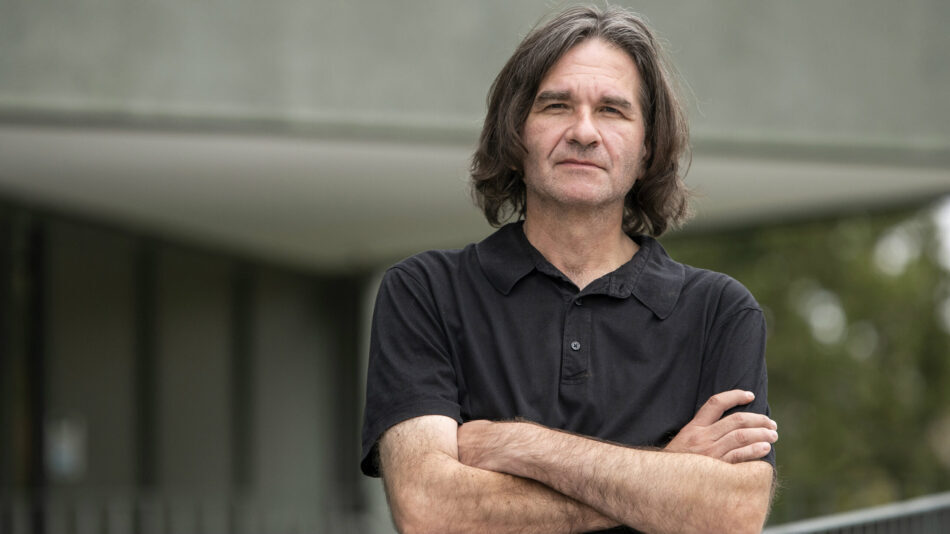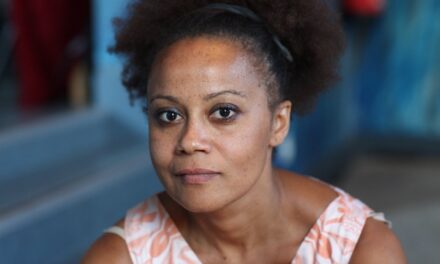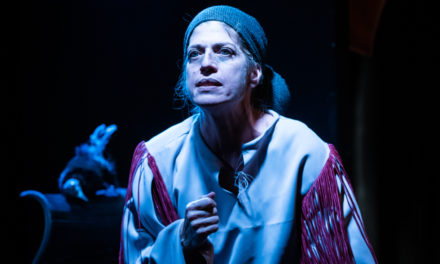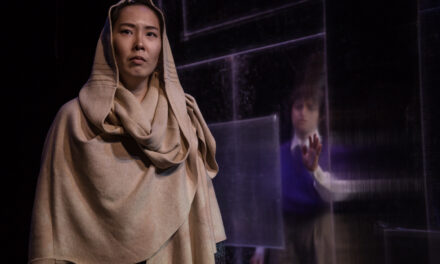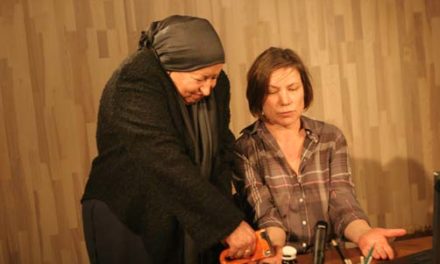Witch. Icon. Legend. Showman – Marina Abramović is all of that, and more.
“I realized then that the public can kill you. If you give them total freedom, they will become frenzied enough to kill you.”, says the artist in 1974, after the performance, Rhythm 0.
“…‘art’ which is a personal evil and refers to the dark cults!” Abramović describes what Polish religious groups and right-wing media said about her work in 2016. “So everything in my childhood is about total sacrifice, whether to religion or to communism. This is what is engraved on me. This is why I have this insane willpower,” she says in 2010.
Her art is a seductive construction of a number of layers that are available to be explored separately, or all at once. This is demonstrated in the first major European retrospective of her work, The Cleaner, which was conceived in close collaboration with the artist. It showcases more than 120 artworks by Marina Abramović, including early paintings and drawings, objects used in the performances, photos, audio works, video installations, films, scripts, re-performances, and archival materials. The project was launched in 2017 at the Moderna Museet (Sweden). The Cleaner was subsequently exhibited at Louisiana Museum of Modern Art (Denmark), Henie Onstad Kunstsenter (Norway), Bundeskunsthalle (Germany), Fondazione Palazzo Strozzi (Italy) and the Centre of Contemporary Art “Znaki Czasu” (Poland).
The last stop of this tour in September 2019 was the Museum of Contemporary Art in Belgrade – the city where she was born in 1946, and where her career began 44 years ago. Back then, it was the capital of now-former Yugoslavia, today it is the capital city of Serbia. Further, her last solo exhibition in the city of her birth opened in 1975, at the Salon of the same museum. Until now, she has returned only for private visits. Because of that history, the opening of The Cleaner in Belgrade holds unique significance for the artist, The Museum of Contemporary Art in Belgrade and for Serbia. The exhibition ended on January 20th, and the next major event that the art world is looking forward to is After Life – the first-ever UK exhibition spanning her life’s work, which will open on September 26th, 2020 in London, making Marina Abramović the first female artist to host a major solo exhibition in the main galleries of the Royal Academy of Arts.
Kremena Hristova and Ina Doublekova met with the curator of the Serbian exhibition and lead curator of The Museum of Contemporary Art in Belgrade, art historian Dejan Sretenović, to talk about the meaning of Marina Abramović’s art, and the exhibition from different perspectives.
Kremena Hrisova and Ina Doublekova: “‘Boss, is this art or I can clean it?’” asked the cleaning lady at the Museum of Contemporary Art each morning, before starting to work”, goes the popular anecdote, which nicely exemplifies the boundary and confusion that contemporary art can cause. So, let’s start there: how do people who clean the Museum of Contemporary Art in Belgrade perceive the exhibition, entitled The Cleaner?
Dejan Sretenović: (Laughs) I think that everybody is excited because they realize that Marina Abramović is a great artist. The cleaning team consists of experienced people who are used to even more eccentric works than this, believe me. But, the security is outsourced and the guards are not so familiar with contemporary art. When they first came, they were like, “uhhh, what’s this?!” But they got used to it, and were very helpful.
K.H & I.D: Belgrade is the seventh city presenting The Cleaner. How does the exhibition change from one city to another, and how much each local curator can alter it?
D.S: The exhibition in Belgrade is smaller than the other six because I especially wanted to show Marina Abramović’s recent period of work. At the same time, we added a few pieces which were not shown in all the other cities. For example, the original gigantic blue dress from Seven Easy Pieces is on display in Belgrade for a first time, which was Marina’s suggestion. We also included Sound Corridor, which is an interesting, early piece that is also kind of symbolically attached to our institution, as it was originally created at the Museum for Contemporary Art here in Belgrade, back in 1972. It was both Marina’s first piece ever exhibited at our museum, and the first time she ever exhibited anything in a museum. Still, the exhibition is a coproduction and most of the content is indisputable. At each location, the curator makes their versions. So I would say that here in Belgrade, you can see a version of The Cleaner exhibition.
K.H & I.D: What was your narrative strategy as a curator when you were preparing the exhibition? What were the elements you built your version upon?
D.S: The structure was already provided by colleagues from Stockholm who launched the project. It has a chronological order because Marina’s work has really different phases. For example, the first phase is in the 1960s through early 1970s, when she was mainly painting, and there are also conceptual works, including sound works. After that comes her so-called, “early solo performance period” of 1973 through 1975. Later, she meets Ulay and this period is a different story – they are doing their duet performances. At this point, I disrupted the chronology of the exhibition with Balkan Baroque, which was performed in 1997 in Venice. Around 2000 and since, other pieces such as Balkan Erotic Epic came out – you can see them in the museum as well. Then you reach the last floor of the Museum, where The Cleaner is shifting focus to the audience – it is addressing you, saying, “so, you saw Marina’s work, now its time for you to perform.” That last floor shows work where the audience is invited to actively participate. The exhibit strategy depends on the curator to tell the story and interpret the objects, but also the space matters.
K.H & I.D: What were the major challenges that the architecture of the Museum of Contemporary Art in Belgrade posed, and how did you deal with them?
D.S: I worked with interior designers trying to solve one of the biggest challenges we faced: how to place all of the video installations into the open space of the museum with its glass walls, and to simultaneously meet the specificities of sound and image. When you have a space like this, you are doing harm if you split it with black boxes or something similar. So I think they came with the right idea, which can be seen onsite now – using transparent screens within the space on which the videos are projected, instead of the more common approach where recordings are projected on walls. It created a new way of presenting the body in performance.
K.H & I.D: Going beyond the museum as a building, what relationship should museums as institutions have to performance art? And, how do you see the relationship between presentation and representation within the live-ness of the performance and its link to theater?
D.S: That’s a question and debate on the theory of performance. I think that Marina was the first one who broke down some of these dogmas. If you read her statements from the 1970s, she will tell you that theater is the enemy of the performance, because everything in theater is fake. “When I was younger, I hated theatre…”, she said, “…it is a form.” While the blood in performance is real, in theatre it’s fake. The knife in performance is real and in theatre it’s is fake, the wounds are real, etc.
But later when asked, “so, how did it come that you turned towards theatre,” she said, “I was tired, exhausted, I was disoriented after breaking up with Ulay, I was not able to perform solo anymore. If you want to tell your story, and your family’s story, you have to go into fiction.” This is how, through a few recordings of her performances, she started to re-perform, though not completely – just excerpts, and parts of her early solo performances.
However, it is still a discussion as to whether re-performing is closer to theatre. I would say that art historians and museum curators are interpreting this topic from completely different perspectives, The hybridization of theatre and art performance should not seen as bad, as such.
K.H & I.D: You mentioned the different backgrounds of people involved in the art scene. In many places, especially in academia, the debate on who has the right to be involved in the field of performing arts is ongoing. On the other hand, from the history of art, we know that this field is developing namely because it is so intersectional and people with different backgrounds are working together and finding out new things. What is your take?
D.S: To raise this question now is completely useless, because many visual artists use theatre forms, and vice versa. It is a time of interdisciplinarity, and I do not see any problem with a variety of backgrounds and their collaboration. For example, you have theatre installation as a new form – actually, not so new – and you can watch a show without actors, which is quite close to visual art itself. Thus, such a debate is a thing of the past.
For example, when Marina Abramovic is acting, when she is not doing performance art but theatre performance, what are the outcomes? The whole of her opus, when you look at it now, is a small compendium of different performing genres. She started with body art, duet performances, and long-duration performance, she introduced re-performance as a legitimate genre of performance, object-based participatory performance, performance with animals, biography, family biography, and biography about Yugoslavia, etc. These are really different kinds of performances. She is a case study for young performers – to learn, to be brave, to know different genres.
K.H & I.D: The exhibition also sparked another debate, which I thought we solved years ago: is performance art an art, or not? Even in the art academy, there is a conservative minority who believes that performance is not art and it is not good for reputations to show any of it.
D.S: Works of Marina Abramović often relate to spirituality, yet, when The Cleaner opened in Catholic Poland for instance, there were religious people protesting and accusing her of Satanism. How can contemporary art react to this rising conservative wave?
“I traveled to the East to get knowledge and serve as a preacher between East and West, because I transfer this knowledge to the West. People do not go to churches anymore, they go to museums. In other words”, says Marina, “I am a guru”.
Contemporary art is so-called “spirituality without religion” – that was Marina’s claim. But people who are judging contemporary art from religious perspectives would never accept this. There were a few voices against it here as well, a few columns in the newspapers, some statements from a distinguished professionals.
K.H & I.D: How is the response to the exhibition in Serbia? Is it important that this exhibition is happening in Belgrade, in this museum, in Serbia in 2019 and if so, for whom?
D.S: For years, there has been criticism against the museum from local circles because we were not showing Marina Abramović. But without state support for the museum to organize such an event, it was impossible. To answer your question: I think it is important, because it is part of Yugoslavian and Serbian art history.
It also increased the visibility of the institution and the country. The show attracted many people who have never been to Belgrade or our museum before. At the same time, we should agree that it is not something too creative, because everyone could have Marina’s exhibition if they have the budget. For example, the Royal Academy in London is showing it next year, she is the first living female artist exhibiting there.
K.H & I.D: And this time it seems that you have support of the government. In all official materials, it is clearly stated that it is supported by the Government of the Republic of Serbia. The Prime Minister Ana Brnabic went to the opening of The Cleaner in Stockholm and personally invited Marina Abramović.
D.S: This causes a lot of noise in the opposition circles. The problem is that there are quite a lot of conflicts in Serbia now. People are full of anger at the government and take every opportunity to criticize it no matter if it makes sense or not. I had to explain that Marinа would never exhibit here without guarantee from the state because she knew from the very beginning that the museum alone cannot accomplish such a show.
K.H & I.D: Do you think that the exhibition served its declared purpose to attract young people, and to make young Serbians believe that culture is important?
D.S: Actually, we already gained a new audience when we opened in 2017. Organized school groups came to the museum – never in its history had it had such an attendance from young people. The exhibition also attracted their attention, though not so actively. But let’s be honest – it is not about attracting. You have to nurture this audience and educate it.
This post was written by the author in their personal capacity.The opinions expressed in this article are the author’s own and do not reflect the view of The Theatre Times, their staff or collaborators.
This post was written by Ina Doublekova.
The views expressed here belong to the author and do not necessarily reflect our views and opinions.

